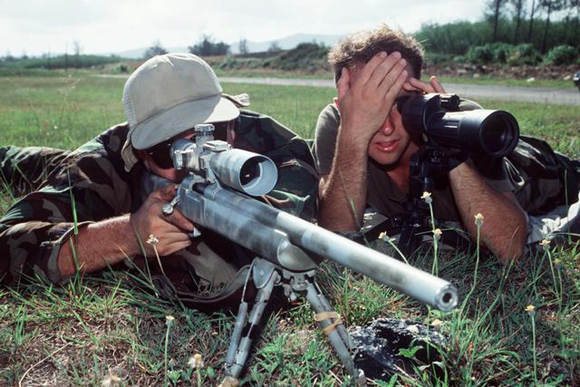Terry Pratchett computer sniper-scope: Spec-ops mini version
Famous Pentagon boffinry powerhouse DARPA has made a new announcement on its “One Shot” programme, which ensures that a million-to-one shot will – as on Terry Pratchett’s Discworld* – hit the target nine (well, six) times out of 10.

Seems that Chad on the right there may be out of a job, these days.
The existing One Shot prototype systems are designed to replace the telescope used by the spotter of a military sniper team. The new, enhanced instrument from DARPA doesn’t merely magnify the target area or measure the range precisely as one can with a normal laser rangefinder: it can also overcome the sniper’s greatest bugbear, that of trying to work out the effect crosswinds will have on the bullet as it flies towards the target.
The One Shot systems does this by analysing the returns from its laser shining on the target and computes just where the sniper’s rifle should be aimed so that the bullet will still arrive on target. This information is fed from the spotter’s instrument to a display attached to the telescopic sighting scope on the actual rifle.
According to DARPA, trials with prototype One Shot systems have shown that two-man sniper teams packing such kit could in fact score first shot hits at least six times in 10 at extreme ranges – as much as 90 per cent of a weapon’s maximum reach. They have spoken previously of 1500m, but this would suggest first shot hits in crosswind at ranges well beyond 2,000m. (The current combat sniping world record holder – publicly known, anyway – is Corporal-of-Horse Craig Harrison of the Household Cavalry, who killed two Taliban machine gunners at 2,474m in 2009. But he took several shots to get on target, and conditions were windless.)
Normally such performance would surely qualify as “million-to-one”: but not anymore, it seems. However DARPA has now announced that some military testers are still not entirely happy with the One Shot as it stands. According to the agency:
Some users of this technology have expressed interest in a significantly smaller “field ready system” that can be “clipped-on” directly to the weapon, eliminating the need for a spotter/observer in future sniper operations. In response to this requirement, DARPA is initiating a new program (One Shot XG) to address this unique implementation approach.
This would dispense with the spotter and his scope altogether, allowing a solo sniper to carry all the necessary computing and instrumentation kit as a small accessory attached to his weapon.
There can’t be much doubt as to who the “some users” referred to by DARPA are: they are the secretive super-troopers of the US Special Operations Command. We know this because in this solicitation (PDF) issued by the Special Operations Research, Development and Acquisition Center earlier this year a requirement for a very similar system to One Shot XG is outlined – and it is specifically stated that “Long Range Sniper Ballistic Solution Systems” are wanted by SOCOM, one of the purposes of which is to “assist the sniper in operating more effectively without the support of a spotter”.
It would seem that the fashion in the US special-ops community is moving away from conventional two-man sniper teams and towards solo operations, at least in some roles or missions: and that – given that it’s not just DARPA working on this – computing sniper scopes are genuinely on their way. Once the trendy special forces have something, the regular forces will generally develop a strong desire for it. ®
Bootnote
This principle was first established in Guards! Guards!, where the Night Watchmen of Ankh-Morpork are attempting to shoot down a dragon with an arrow.
Article source: http://go.theregister.com/feed/www.theregister.co.uk/2011/11/24/darpa_one_shot_spec_ops_mini_version/